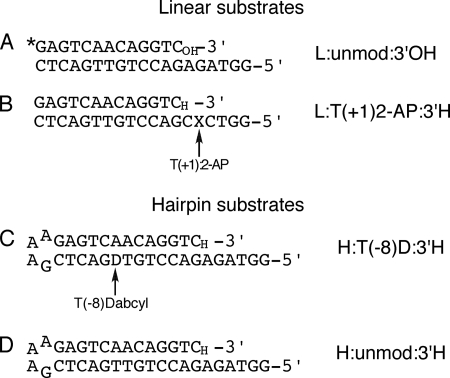FIGURE 3.
Oligonucleotides used in this study. A, DNA substrate used in chemical quench experiments. The 13-mer primer, 5′-labeled with 32P (indicated as an asterisk), was annealed to the 19-mer template. B, DNA duplex oligonucleotide used for 2-AP fluorescence measurements. The 2-AP fluorophore (X) was placed 5′ to the templating base, designated as the T(+1) position (relative to the templating position as 0 in our numbering system). C, hairpin DNA substrate used in FRET-based fluorescence measurements of fingers-closing. The dabcyl-dT quencher was placed at the T(−8) position. D, as in C but without the dabcyl quencher, used as a control for the FRET-based measurements. Except for A, the primer strand was dideoxy-terminated (3′H) so as to prevent the reaction from proceeding beyond the ternary complex. In some experiments, extendable (3′OH) versions of B–D were also used. All DNA substrates employed essentially the same duplex DNA sequence. The observed rates of fluorescence changes or of dNTP incorporation in our assays are altered very little by changing the templating base (2, 3).

